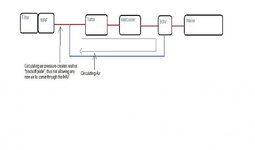daver36
10+ Year Contributor
- 41
- 0
- Jan 30, 2009
-
Orangeville,
Ontario_Canada
Hey guys,
I'm asking this question at the moment not owning a dsm, but being a huge fan (and hopeful owner one day) and wanting to know all I can about them. I know you can't vent to atmosphere with the maf is stock location because the maf will meter air that the intake never sees, richening the mixer on deceleration and causing stalling/a bad running engine. I can accept this but it never fully made sense to me. At first I thought "ya, but even with air recirculating while the bov is "engaged" the trottlebody plate is still closed to no air can get in anyways and the MAF can still meter air. As I was thinking about how to write this question I think I can up with the answer, one that makes sense to me anyways. Basically I figured that since the recirculating air circles from turbo to BOV and back to turbo (post MAF) this circulating air could me creating a "block off plate" out of air pressure. This would in essence not allow new, fresh, and more importantly, metered air to come through the filter and into the MAF, thus making sure the MAF doesn't see anymore air coming in, and doesn't tell the ECU to add more fuel. So basically my question is, is my guesstimation on the the topic correct? If not, what is the real science behind it? Like I said before, I love learning all about these things. Come some day in the future when I get my dsm, I don't want and questions and doubts about my own build path. I included this pic to help illistrate what I'm trying to convey in my ramblings.
Cheers,
Daver
I'm asking this question at the moment not owning a dsm, but being a huge fan (and hopeful owner one day) and wanting to know all I can about them. I know you can't vent to atmosphere with the maf is stock location because the maf will meter air that the intake never sees, richening the mixer on deceleration and causing stalling/a bad running engine. I can accept this but it never fully made sense to me. At first I thought "ya, but even with air recirculating while the bov is "engaged" the trottlebody plate is still closed to no air can get in anyways and the MAF can still meter air. As I was thinking about how to write this question I think I can up with the answer, one that makes sense to me anyways. Basically I figured that since the recirculating air circles from turbo to BOV and back to turbo (post MAF) this circulating air could me creating a "block off plate" out of air pressure. This would in essence not allow new, fresh, and more importantly, metered air to come through the filter and into the MAF, thus making sure the MAF doesn't see anymore air coming in, and doesn't tell the ECU to add more fuel. So basically my question is, is my guesstimation on the the topic correct? If not, what is the real science behind it? Like I said before, I love learning all about these things. Come some day in the future when I get my dsm, I don't want and questions and doubts about my own build path. I included this pic to help illistrate what I'm trying to convey in my ramblings.
Cheers,
Daver





















